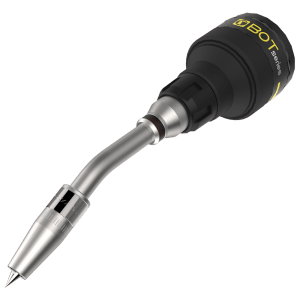Keys to choosing the right robotic welding torch
Choosing between an optimal or inadequate robotic torch, could mean the difference between reaching your weekly quality and productivity targets, and struggle to meet promised lead time. To help you select the most convenient torch for your welding application and maximize the efficiency of the operating team, quality and profitability, you should consider these 8 key points:
1.Understanding the Tool Center Point (TCP)
Tool Center Point, or TCP, is a point in space with a mathematical reference to the flange of a robot. For robotic welding GMAW, this is mainly how the robot knows where the tip of the welding wire is. Robots are good at repeating the same movement path over and over again, if the tip of the welding wire changes due to thermal or physical distortion, the placement of the weld will change. In extreme cases, the torch will collide with the piece or welding
A change in TCP over time means that the robot will deposit the weld bead somewhere other than the center of the joint. When this happens, operators can compensate for the deviation of the TCP by increasing the width of the bead, for example by reducing the speed of movement or by programming a slight oscillation in the movement of the torch, to ensure that the weld covers both pieces and provides sufficient fusion, all this as a result of incorrect TCP. Longer weld seams increase the costs of filler metal and gas, cycle time, heat input and total welding cost. In short, compensation kills profitability in automated welding and can compromise mechanical properties as well. The selection of a robotic torch with a consistent TCP can be the first step in improving welding and reducing the consumption of filler metal.
The TCP is the most important attribute to consider when evaluating robotic torches. To ensure consistent and repeatable TCP, look for robust necks and accurate and stable mounting systems.
2.Evaluate configurations and necks
While a 23-degree bracket with a 22-degree neck basically offers the same amount of curvature as a 0-degree bracket with a 45-degree neck, this latter combination works better for welding small circles, such those around an axis. With a 45-degree neck, the torch can rotate around the robot’s sixth axis (where the torch is mounted to the robot’s arm) in smaller circles. On the other hand, a 0-degree mount with a 22-degree neck works well when it is needed to reach a small opening.
If you have an application convenient for a 45-degree neck and another application where a 22 degree neck woud work better, select a torch pack with a modular design. This allows you to change the neck of the torch pack (without tools) and insert the most suitable neck for the application. For workshops, this modular approach adds flexibility and reduces the changeover time between parts.
3.Torches rotation.
The answer depends on the number of required programming points and the duration of time between them. The external wires of a conventional torch limit the rotation of the arm to +/- 240 degrees. After making a circular weld, the next point in the program brings the torch to a safe space and unrolls the cable. With a slew coupling of +/- 360 degrees, the arm can move directly to the next weld. Torches with more turning angle reduce programming time, as well as reduce unproductive .
4. Torch configuration test.
Before the setting-up of the installation begins, request a 3D model and in virtual reality. This will guarantee the correct selection of the torch before purchasing.
5. Stability of the gas nozzle.
There are two systems for fastening a gas nozzle to the torch neck. Threaded nozzle that has the advantage of being more reliable and leads to less leakage of protective gas. But if it is not well designed and tighted, it can loosen with thermal changes. There are also nozzles with pressure clamping, this system can offer better cooling but also greater gas losses through the grooves, besides the clamping is not as safe as with the threaded system.
There are systems where both methods are combined and have the advantages of both, but it is difficult to maintain that advantage with the use and wear of the nozzle and they end up losing gas or not maintaining the pressure of the grooves.
6. Shield and purge system.
It is important to consider that the torch system for robots is equipped with a purge tube. This tube is independent of the shield gas one, and it is used for the cleaning tasks of the torch. It is important that both gas systems are separated from the welding wire conduit, the wire causes dust due to its wear and offers resistance variations to the gas flow.
The best welding torch systems are equipped with independent circuits for each type of gas-flow.
7. Use the most durable consumables .
When analyzing the consumables, you must consider both the cost of maintenance time and the cost differences between consumables. In most cases, the costs of downtime are significantly higher than the cost of consumables. We recommend that you use your long-lasting CuCrZr contact tips and consumables to ensure the longest possible life, as it will help avoid unplanned downtime and reduce the welding cost.
8. Take into account the cable coverings.
The rotation of the arms of the robots together with the combination of the heat generated by the welding makes the outer casing of the torch subject to a great thermal-dynamic effort, therefore it is advisable to choose the cover in materials such as PA . If the welding environment is particularly extreme, it is possible to cover the cover with outer covers such as Kevlar, aluminized fabrics or treated leather.
José Carlos M.
Share this article!
Contact the author for more info!

